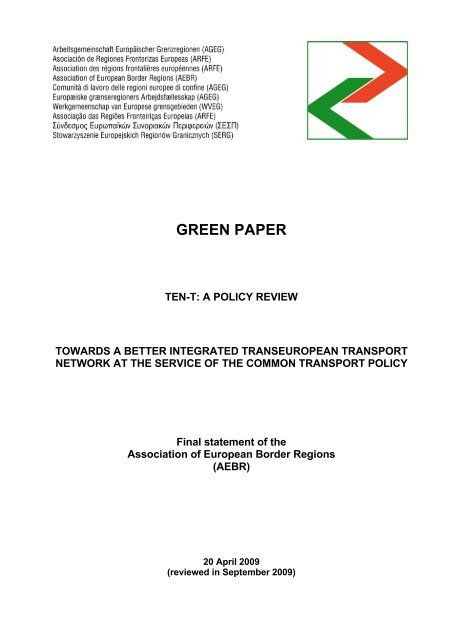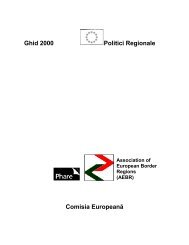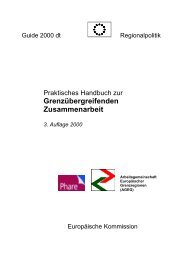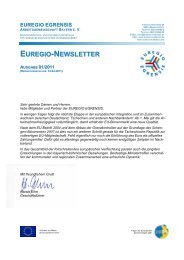GREEN PAPER - Association of European Border Regions
GREEN PAPER - Association of European Border Regions
GREEN PAPER - Association of European Border Regions
You also want an ePaper? Increase the reach of your titles
YUMPU automatically turns print PDFs into web optimized ePapers that Google loves.
<strong>GREEN</strong> <strong>PAPER</strong><br />
TEN-T: A POLICY REVIEW<br />
TOWARDS A BETTER INTEGRATED TRANSEUROPEAN TRANSPORT<br />
NETWORK AT THE SERVICE OF THE COMMON TRANSPORT POLICY<br />
Final statement <strong>of</strong> the<br />
<strong>Association</strong> <strong>of</strong> <strong>European</strong> <strong>Border</strong> <strong>Regions</strong><br />
(AEBR)<br />
20 April 2009<br />
(reviewed in September 2009)
Preface<br />
Founded in 1971, the <strong>Association</strong> <strong>of</strong> <strong>European</strong> <strong>Border</strong> <strong>Regions</strong> (AEBR) is the only<br />
<strong>European</strong>-wide international organisation dealing with cross-border cooperation all over<br />
Europe. Our more than 100 members are representing more than 200 border and<br />
cross-border regions. This “Statement on the Green Paper: TEN-T: a policy review” was<br />
developed on behalf <strong>of</strong> our members. Therefore it is focussing on cross-border<br />
cooperation (some arguments had to be repeated under different headlines).<br />
1. General<br />
The <strong>Association</strong> <strong>of</strong> <strong>European</strong> <strong>Border</strong> Region is appreciating the presentation<br />
<strong>of</strong> the Green Paper to date.<br />
Like the Commission, AEBR’s point <strong>of</strong> view is that the results <strong>of</strong> TEN-T<br />
achieved up to now are vindicating not only a review <strong>of</strong> the present policy<br />
and an update <strong>of</strong> the plans, but moreover a fundamental revision <strong>of</strong> the<br />
TENT-T policy is required.<br />
Transport networks for the EU mean not only (like before) to connect<br />
essential national networks for the common carriers. They require rather a<br />
conceptual political approach.<br />
A TEN-T policy should provide the necessary infrastructure to ensure the<br />
access to the transport networks and to support the economic, social and<br />
territorial cohesion.<br />
Beyond the common objectives <strong>of</strong> the transport policy (support <strong>of</strong><br />
economic, ecologic efficient and reliable transport services) it should ensure<br />
that:<br />
o this services are as efficient as possible,<br />
o they base on an integrated and innovative infrastructure which can keep<br />
up with the technical development,<br />
o good connections to all neighbouring countries are guaranteed,<br />
o an essential <strong>European</strong> master plan is going to be linked wisely with the<br />
national strategies in the individual member states.<br />
A <strong>European</strong> network concept where priority projects are well integrated<br />
seems to be a good approach. Thereby the different requirements <strong>of</strong><br />
commercial transport and passenger traffic has to be taken into account as<br />
well as the key role <strong>of</strong> the airports and ports in the globalisation <strong>of</strong> the<br />
commercial transport logistics and <strong>of</strong> the transport on waterways in the EU<br />
with important links to great seaports (e.g. highways <strong>of</strong> the sea) and great<br />
industry areas (e.g. in-land water ways).<br />
According to statements <strong>of</strong> the Commission cross-border connections are<br />
thereby <strong>of</strong> crucial importance.<br />
AGEG/AEBR/ARFE / Enscheder Str. 362 / D-48599 Gronau / Tel.: 0049 2562 70219 / Fax: 0049 2562 70259<br />
info@aebr.eu / www.aebr.eu<br />
2
2. Possible options for further TENT-T development<br />
The Commission considers three options for further TEN-T development to be<br />
possible:<br />
(1) Maintaining the current dual layer structure with the comprehensive<br />
network and (unconnected) priority projects,<br />
(2) Reducing the TEN-T to a single layer (priority projects, possibly connected<br />
into a priority network),<br />
(3) Dual layer structure with the comprehensive network and a core network,<br />
comprising a – geographically defined – priority network and a conceptual<br />
pillar to help integrate the various transport policy and transport<br />
infrastructure aspects.<br />
3. Statement <strong>of</strong> the AEBR on the structural options on the creation <strong>of</strong> TEN-T<br />
Option 1 with dual layer: Comprehensive network and priority projects: The current<br />
structure <strong>of</strong> TEN-T policy should not be pursued. The disadvantage <strong>of</strong> lack <strong>of</strong><br />
influence <strong>of</strong> the EU on the due-process and entire completion as well as the insufficient<br />
effect <strong>of</strong> the network is too serious. The advantages can be further realised with option<br />
3.<br />
Option 2 with one new layer: Priority projects - possibly in extended form: The<br />
concentration on the main community instruments is a progress. Within the priority<br />
projects (core network) this would result in reviewable and verifiable improvements for<br />
border and cross-border areas.<br />
The lacking influence on the comprehensive network with additional political<br />
transport functions is a decisive disadvantage, especially as the EU-level would no<br />
longer take care <strong>of</strong> intersections, gateways, cross-border links, hinterland connections<br />
and accessibility <strong>of</strong> ports and airports in border areas not belonging to priority<br />
measures.<br />
Option 3: Dual layer with a comprehensive network and a "core network“: The whole<br />
<strong>European</strong> transport network with all carriers and transport management systems will<br />
remain in the political field <strong>of</strong> action <strong>of</strong> the EU. At the same time priority projects can<br />
create considerable advantages by the scheduled core network with a geographical<br />
pillar (deduced from the present constellation <strong>of</strong> priority projects) and a conceptual pillar<br />
(to determine further projects on the basis <strong>of</strong> common criteria). Especially, the EU can<br />
connect the core network and comprehensive network. This will guarantee a better<br />
concentration on the priorities.<br />
All border and cross- border areas will stay in the focus <strong>of</strong> the EU-policy and<br />
possible measures. Even peripheral areas and their access and opening for airports,<br />
ports and cross-border secondary networks in connection with the primary networks will<br />
remain under their political monitoring.<br />
Disadvantages like lack <strong>of</strong> funds and “uncertain” factors in the TEN planning are not so<br />
severe. Even today there is a lack <strong>of</strong> funds, also on EU-level, so that the main<br />
responsibility remains to the national member states. Plans are always related with<br />
“uncertain” factors.<br />
AGEG/AEBR/ARFE / Enscheder Str. 362 / D-48599 Gronau / Tel.: 0049 2562 70219 / Fax: 0049 2562 70259<br />
info@aebr.eu / www.aebr.eu<br />
3
Conclusion: For border and cross-border areas option 3 is the best solution due to<br />
their <strong>European</strong>-wide political approach while emphasising the priorities at<br />
the same time, the connection <strong>of</strong> cross-border transport routes, the<br />
allocation <strong>of</strong> Intelligent Transport Systems (ITS) as well as provision for<br />
airports and ports in border areas. Some border areas will even gain more<br />
benefit because they are located in priority corridors. Others can argue<br />
considerably better, <strong>of</strong>fer solutions and carry out lobby work as within<br />
option 1 and 2 because they remain in the focus <strong>of</strong> the EU-policy.<br />
4. Initial position <strong>of</strong> the border regions as well as future needs and<br />
requirements<br />
4.1 Initial position <strong>of</strong> <strong>European</strong> border regions regarding future transport<br />
developments<br />
Just like the AEBR Charter, the White paper <strong>of</strong> the EU from 2002 "<strong>European</strong> Transport<br />
Policy for 2010: Time to Decide" rightly highlights the fact that in border areas the<br />
current infrastructure networks still reflect the narrow national principles<br />
(sometimes going back to the 19 th century) which influenced their construction,<br />
particularly from the military point <strong>of</strong> view.<br />
Indeed, right from its inception (1971), the <strong>Association</strong> <strong>of</strong> <strong>European</strong> <strong>Border</strong> <strong>Regions</strong><br />
(AEBR) took a very close interest in issues related to transport policy in the<br />
border regions. Many border areas have suffered from their peripheral location<br />
(national, sometimes even <strong>European</strong>) for decades resulting from missing transport<br />
infrastructure. Only the removal <strong>of</strong> economic, social, cultural, traffic and legal barriers<br />
and with the integration <strong>of</strong> Europe into a unity in diversity the previous peripheral<br />
situation <strong>of</strong> many border regions can be transformed into a favourable central<br />
location within Europe. <strong>Border</strong> regions at the external borders <strong>of</strong> the EU can be<br />
released from their isolation through improved connections. <strong>Border</strong> and cross-border<br />
regions will thereby function as bridges and become touchstones <strong>of</strong> <strong>European</strong><br />
Integration.<br />
Where transport infrastructures still have to be developed, the physical preconditions for<br />
cross-border development orientated on the future are <strong>of</strong>ten absent.<br />
4.2 General requirements for a future transport policy<br />
Compared to the national governments the future role <strong>of</strong> the Commission has<br />
to be defined clearly in the framework <strong>of</strong> TEN-T.<br />
„Outline Plans“(network schemes for all kind <strong>of</strong> transport) should<br />
preferential developed by the EU (in cooperation with the member states)<br />
whereby also national transport policies can be coordinated better.<br />
A long-term network planning helps to improve the connection <strong>of</strong> border-<br />
and peripheral regions with the central areas <strong>of</strong> the EU so that they can<br />
meet the new challenges (climate change, energy supply, need <strong>of</strong> new<br />
infrastructures, connections at the new borders, etc.).<br />
AGEG/AEBR/ARFE / Enscheder Str. 362 / D-48599 Gronau / Tel.: 0049 2562 70219 / Fax: 0049 2562 70259<br />
info@aebr.eu / www.aebr.eu<br />
4
Priority projects in the framework <strong>of</strong> these “Outline Plans” and long-term<br />
network planning should create a <strong>European</strong> added value.<br />
As the needs <strong>of</strong> international infrastructures better have to be taken into<br />
account, an isolated national planning is rather obsolete.<br />
Changes <strong>of</strong> political priorities in a member state may not cause that<br />
investments in an international corridor are hindered or measures in the<br />
neighbouring country have to be postponed.<br />
4.3 Individual transport sectors<br />
Transport corridors (roads and railways)<br />
Road and railways corridors have to be well integrated in the common<br />
network.<br />
International transport corridors for roads and railways must be based on<br />
the network users’ needs (demand-oriented capacities).<br />
Internationals corridors are requiring common quality standards and an<br />
improved interoperability (especially railways).<br />
Water transport<br />
As the transport on water has the largest transport capacities, an improved<br />
use requires:<br />
o good infrastructural connection <strong>of</strong> the ports to the hinterland,<br />
o cooperation between ports (information networks),<br />
o integration <strong>of</strong> ports in logistic transport chains,<br />
o modern river information systems.<br />
Maintenance <strong>of</strong> waterways and elimination <strong>of</strong> bottlenecks (especially in<br />
border areas).<br />
Improving the connection with secondary networks.<br />
Highways on the Sea with highly integrated transport chains.<br />
Aviation<br />
Policy <strong>of</strong> a Single <strong>European</strong> Sky (especially in the field <strong>of</strong> control and<br />
management <strong>of</strong> the aviation).<br />
Airport capacities with an adequate infrastructure on the ground, “green<br />
airports”, etc., to meet the increasing air traffic.<br />
Airports with an improved railway connection.<br />
More attention for regional airports because <strong>of</strong> their importance for border-<br />
and peripheral areas.<br />
New technologies<br />
Transition from a rather hard infrastructure to intelligent transport systems<br />
(e.g. Galileo).<br />
Innovation and technological development as rather long-term<br />
instruments (e.g. development <strong>of</strong> hybrid vehicles, etc.).<br />
AGEG/AEBR/ARFE / Enscheder Str. 362 / D-48599 Gronau / Tel.: 0049 2562 70219 / Fax: 0049 2562 70259<br />
info@aebr.eu / www.aebr.eu<br />
5
5. Special needs and requirements <strong>of</strong> border and cross-border areas<br />
In the Green Paper on TEN-T the <strong>European</strong> Commission states that cross-border<br />
connection <strong>of</strong> transport systems is one <strong>of</strong> the main tasks for the future. Therefore,<br />
border and cross-border regions must get special support by the EU. This results in<br />
concrete needs and requirements:<br />
Spatial development, regional and transport policies have to be<br />
considered together and coordinated more efficiently than in the past, if<br />
border areas are to enjoy sustainable development.<br />
Common cross-border planning <strong>of</strong> infrastructure should take into account<br />
spatial planning and regional policies on both sides <strong>of</strong> the border, rather than<br />
merely technical criteria (such as traffic volumes and flow).<br />
Regional policies and cross-border strategies / plans have to make concrete<br />
proposals for the coordination / harmonisation <strong>of</strong> infrastructural measures<br />
and the elimination <strong>of</strong> border related barriers.<br />
The construction and expansion (through public and/or private financing) <strong>of</strong><br />
roads, railways, airports, navigable waterways, ferries and harbours is<br />
extremely important for border regions, including closing <strong>of</strong> missing links<br />
between regional / national and Trans-<strong>European</strong> traffic axes and networks.<br />
International transport connections through border and cross-border<br />
regions must link them with national and regional transport networks and<br />
centres. Only the specific regional connection and utilisation <strong>of</strong> large<br />
infrastructures removes border-related ”bottlenecks”, makes border regions<br />
become bridges between national states and neighbouring regions; and<br />
contributes simultaneously to the internal development <strong>of</strong> cross-border areas.<br />
International transport connections should not turn the border and crossborder<br />
regions into mere transit areas (e.g. vulnerable areas). The<br />
construction or expansion <strong>of</strong> traffic infrastructure has to take into<br />
consideration the interests <strong>of</strong> the population and the economy <strong>of</strong> the<br />
affected region, as well as the environmental requirements and nature<br />
protection.<br />
<strong>Border</strong> and cross-border regions must use joint development programmes<br />
and strategies to prepare themselves in good time for the realisation <strong>of</strong><br />
major infrastructure projects crossing their border areas, to exploit any<br />
opportunities that arise, and to alleviate any disadvantages. Major projects<br />
relating to traffic infrastructure can be realised only with equal participation <strong>of</strong><br />
the border and cross-border regions concerned,<br />
The implementation <strong>of</strong> major transport routes passing a cross-border<br />
area is also a challenge for the cross-border regions. This has to:<br />
o Develop a multimodal, cross-border transport infrastructure including<br />
traffic centres<br />
o Develop cross-border production and marketing activities in the transport<br />
sector<br />
o Improve the regional interconnection <strong>of</strong> transport operators and related<br />
supply services<br />
o Expand or create cross-border communication networks<br />
Building cross-border infrastructures will enable people to earn a living and<br />
remain there.<br />
AGEG/AEBR/ARFE / Enscheder Str. 362 / D-48599 Gronau / Tel.: 0049 2562 70219 / Fax: 0049 2562 70259<br />
info@aebr.eu / www.aebr.eu<br />
6
6. Conclusions<br />
6.1 Current TEN-T policy – border areas at a disadvantage<br />
26 <strong>of</strong> 30 priority projects <strong>of</strong> the TEN-T policy affect border and cross-border<br />
areas.<br />
Practically in all projects finished up to now the investments on the border were<br />
made at the very end.<br />
Practically in all projects currently being planned or under construction the crossborder<br />
sections will be finished at last.<br />
Major international infrastructure projects are merely built first in the centres<br />
/ agglomerations – if they have got their transport corridors, these centres are not<br />
any more interested what is going on elsewhere.<br />
6.2 Closing cross-border missing links in the future first<br />
As a consequence international / cross-border infrastructure projects have to be<br />
constructed first across the border:<br />
o That will cause pressure on national governments to close the gaps<br />
between the border and the centres<br />
o That will maintain the political support <strong>of</strong> centres / agglomerations for<br />
the total <strong>of</strong> the infrastructural measure<br />
<strong>Border</strong> / cross-border infrastructure could also be pre-financed by private (e.g.<br />
Chambers <strong>of</strong> Commerce representing highly interested enterprises) or regional<br />
money from both sides <strong>of</strong> the border.<br />
6.3 What can be done by the EU in practice?<br />
To give priority to border crossing infrastructural measures<br />
To implement political decisions in the transport sector in favour <strong>of</strong> border<br />
regions<br />
Liable financial concepts in favour <strong>of</strong> cross-border infrastructure (not only<br />
INTERREG)<br />
The coordination <strong>of</strong> EU-subsidies and financial instruments as a prerequisite to<br />
achieve the political modal shift, which transport policy is striking for<br />
Urgent requests for traffic concepts within border / cross-border regions. They<br />
have to be optimised in such a way as to make them economically, socially and<br />
environmentally viable in the long term (due to the huge increase in transport flows<br />
affecting especially border regions)<br />
Solve the problem <strong>of</strong> different transport systems which are not geared to the<br />
requirements <strong>of</strong> the cross-border internal market<br />
Support through intermodal transport (Marco Polo Program)<br />
Linking together border regions trough networks (roads, railways, airports,<br />
navigable water ways, highways on the seas)<br />
Better rail, road and waterway links between the main ports and the transport<br />
networks in the hinterland<br />
Plans for an intelligent management <strong>of</strong> traffic on major roads crossing the<br />
border<br />
7<br />
AGEG/AEBR/ARFE / Enscheder Str. 362 / D-48599 Gronau / Tel.: 0049 2562 70219 / Fax: 0049 2562 70259<br />
info@aebr.eu / www.aebr.eu
New technical regulation on the harmonisation <strong>of</strong> minimum safety standards<br />
(e.g. in tunnels),<br />
A guarantee for the interoperability <strong>of</strong> toll systems in <strong>European</strong> road networks<br />
In road traffic to press for harmonised checks and penalties as well as<br />
qualifications and social provisions in order to ensure suitable working conditions<br />
On the external borders common facilities with common controls (possible if the<br />
staff is trained with modern electronic equipment) in order to accelerate the border<br />
transit<br />
Involvement <strong>of</strong> the EU in the most important international organisations in<br />
the transport sector (especially shipping and railways!)<br />
6.4 Political recommendations for the future<br />
The Green Book should underline the connection between spatial planning and<br />
territorial cohesion more clearly.<br />
On finances and in the political discussion, the EU Commission should focus<br />
primarily on large international measures with cross-border impact, because on<br />
national level these measures have to stay back behind national projects.<br />
The TEN-T policy should encourage Member States to focus on cross-border<br />
projects and thus avoid the risk <strong>of</strong> un-harmonised implementation <strong>of</strong> cross/border<br />
projects.<br />
It has to be assured that the local / regional / national transport planning is<br />
considering TEN-T priorities on the one hand; and, on the other hand, that they are<br />
taken into account in TEN-T (in time involvement <strong>of</strong> local / regional authorities to<br />
develop the TEN-T network and its priorities, because the transport corridors are<br />
running through their areas).<br />
A „<strong>European</strong> Added Value“ has to be assessed in the TEN-T core network<br />
components, such as <strong>European</strong>/cross-border effects.<br />
Attention has to be paid that, parallel to planning and implementation <strong>of</strong> large<br />
transnational projects, the necessary infrastructural links (secondary networks) are<br />
established in the respective member states so that these large-scale networks are<br />
able to work.<br />
The current TEN-T policy should adequately address the Central <strong>European</strong> area,<br />
in particular with regards to the changes due to EU enlargement.<br />
Measures to improve the efficiency and quality <strong>of</strong> transport have to be taken more<br />
into account in TEN-T networks, especially to overcome technical obstacles in<br />
cross-border transport.<br />
It is essential to distinguish clearly between freight and passenger traffic in TEN-T<br />
transport sectors.<br />
In the long-term, a separation <strong>of</strong> freight transport corridors and high-speed lines for<br />
passenger traffic (especially in cross-border corridors) is essential.<br />
EU coordinators for the development <strong>of</strong> key transnational infrastructure project<br />
deployment have to play a more important role.<br />
F:\DATA\334 AGEG\REFERATEundSTELLUNGNAHMEN\2009\Green Book Transport-Networks TENT-V 16-02-09\AEBR<br />
Statement TEN-T EN 18-09-09.doc<br />
AGEG/AEBR/ARFE / Enscheder Str. 362 / D-48599 Gronau / Tel.: 0049 2562 70219 / Fax: 0049 2562 70259<br />
info@aebr.eu / www.aebr.eu<br />
8








